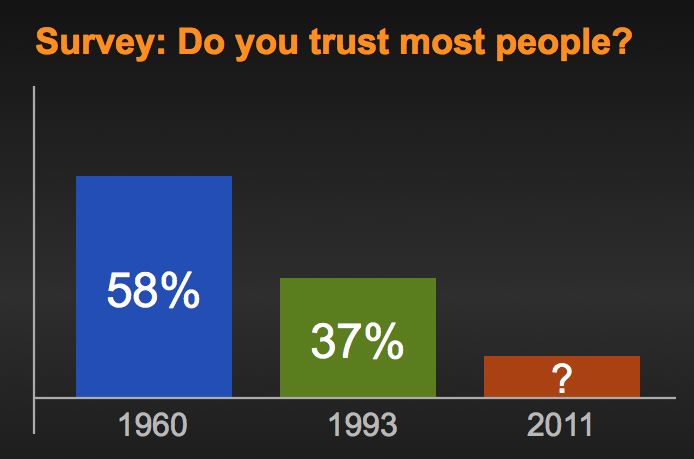
"Do you trust most people?” This was the simple question asked in a survey done in 1960 and again in 1993. In 1960, 58% of respondents said yes. In 1993… just 37%.
With recent leaders like BP CEO Tony Hayward bumbling through press conferences with “I want MY life back,” Dr. Conrad Murray and Bernie Madoff (no explanation necessary for either!), to the housing crisis where many people found themselves in trouble for heeding their “advisor’s” advice, it’s not surprising – we’re conditioned to look over our shoulder and wonder, “What’s the motive here? Can I trust this person?”
Even opening a basic checking account is a questionable experience. Sure, the account is free now, but what kind of fees am I going to see a few months down the line? Considering all of this, we can pretty confidently assume the trust percentage has continued to decrease.
This proves a challenge when connecting with customers and clients. Not only are they more risk averse, but also they’re smart consumers with access to information and motivated to look up the real differences (if any) between you and your competitors.
You have to differentiate yourself by offering them a better experience than anyone else. Knowing that, it’s vital to focus time and resources on building and maintaining trust with your clients. But how? We’re doing a series of posts that offer tips to tackle this otherwise nebulous concept.
The First Step
Listen. It’s a critically important (and very frequently forgotten) element of communication, especially when building trust.
If you only consider your angle, your promotional marketing lingo and buzzwords, what you have to offer, you’re missing out on a major component of message creation: the audience. The first thing you must do before creating any sort of message, even before thinking of a point of view or thesis, is consider them.
- What does my audience care about? (budget, time, hitting quota, lessening workload?)
- Why are they taking the time to talk to me?
- Do they have any preconceptions?
- Are they big picture driven (usually upper management), or more about the facts and figures (typically middle-management)?
- What could make them resistant?
This goes for talking to prospective and current clients alike. Take the time to listen to them and THEN craft a message around their concerns, objectives, and priorities. Not only will you be able to formulate your ideas around what will matter to them, but they’ll feel heard and acknowledged. You’ll come across as someone credible who understands them and cares. So simple, yet, again, so frequently forgotten.
Remember, you’re not just taking the meeting to give information, data dump on them, and promote yourself. You’re listening to their current concerns to better understand them and then influence them to take action.
Many people like Seth Godin are getting creative with trust-building initiatives, so please share anything you’ve tried, successful or not!
Stay tuned for the next steps for rebuilding trust in the coming weeks.
I think Ronald Regan said it best, “Trust but verify.”